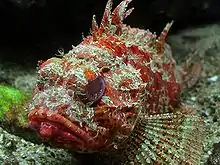Scorpaena scrofa
Scorpaena scrofa, common name the red scorpionfish, bigscale scorpionfish, large-scaled scorpion fish,[3] or rascasse is a venomous marine species of fish in the family Scorpaenidae, the scorpionfish.[2]
| Scorpaena scrofa | |
|---|---|
 | |
| Scientific classification | |
| Kingdom: | Animalia |
| Phylum: | Chordata |
| Class: | Actinopterygii |
| Order: | Scorpaeniformes |
| Family: | Scorpaenidae |
| Genus: | Scorpaena |
| Species: | S. scrofa |
| Binomial name | |
| Scorpaena scrofa | |
| Synonyms | |
| |
Description
Scorpaena scrofa is the largest eastern Atlantic scorpion fish.[4] Its colouration ranges from brick red to a light pink, and it has dark-coloured blotches on its body. It has venomous spines, and can achieve a maximum weight around 3 kg (6.6 lb).[5] It can grow to a maximum length of 50 cm (20 in), but is commonly around 30 cm (12 in).[5]
It has 12 dorsal spines, 9 dorsal soft rays, three anal spines, and five soft rays. It often has a dark spot on its spinous dorsal spines between the 6th and 11th.[5][6] It has long supraorbital tentacles.
Distribution
This species is found in the Mediterranean Sea. It is also found in the eastern Atlantic Ocean around the British Isles, where it is rare, south to Senegal, the Canary Islands, and Cape Verde.[5]
Habitat
S. scrofa is demersal and lives in marine and brackish environments with rocky, sandy, or muddy bottoms at depths of 20–500 m (66–1,640 ft).[5] By day, it lives in burrows and caves. At night it comes out to hunt.[4]
Behaviour
This species is a sedentary, solitary, and nonmigratory fish. It is predatory, feeding on other fish, as well as crustaceans and molluscs.[5] This is one of the fish used by the marine leech Pontobdella muricata as a host.[7]
As food
S. scrofa is a traditional ingredient in Marseille bouillabaisse. It is also widely used in Japanese cuisine.
References
- Nunoo, F.; Poss, S.; Bannermann, P. & Russell, B. (2015). "Scorpaena scrofa". The IUCN Red List of Threatened Species. IUCN. 2015: e.T198748A15592127. doi:10.2305/IUCN.UK.2015-4.RLTS.T198748A15592127.en. Retrieved 22 May 2020.
- Scorpaena scrofa Linnaeus, 1758. 15 January 2019. Retrieved through: World Register of Marine Species.
- "Marine Species Identification Portal : Large-scaled scorpion fish - Scorpaena scrofa". Species-identification.org. Retrieved September 15, 2011.
- "Scorpaena scrofa". Malawicichlidhomepage.com. Retrieved September 15, 2011.
- Froese, Rainer and Pauly, Daniel, eds. (2014). "Scorpaena scrofa" in FishBase. April 2014 version.
- Greece. "Red Scorpionfish (Scorpaena scrofa) | Archipelago Wildlife Library". Wildlife-archipelago.gr. Retrieved September 15, 2011.
- "Pontobdella muricata Linnaeus, 1758". SeaLifeBase. Retrieved 27 December 2019.
External links
- Photos of Scorpaena scrofa on Sealife Collection
- Drawing showing side view
- Image
- Embryonic and larval development of largescaled scorpionfish Scorpaena scrofa (Scorpaenidae)

